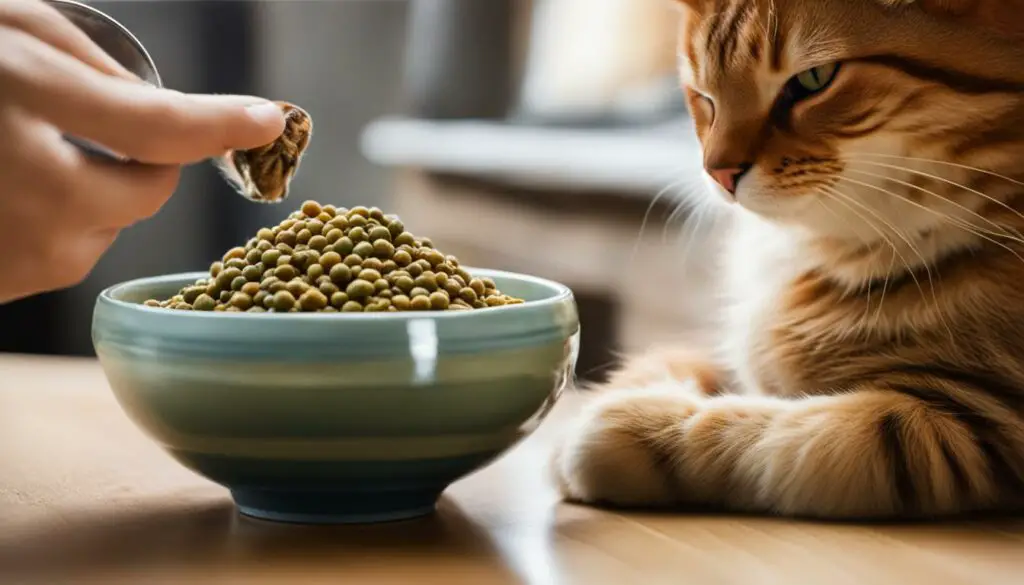Ever wondered why your cat only eats when you pet him? It may seem strange, but this behavior, known as affection eating or attention eating, is quite common among feline companions. When cats engage in affection eating, it’s their way of bonding with their owners and feeling safe while enjoying their meals. It’s an intriguing behavior that highlights the strong connection between love and food for our feline friends.
Key Takeaways:
- Affection eating is a behavior exhibited by many cats, where they only eat when their owners pet them.
- This behavior helps build a bond between cats and their owners and provides a sense of security during mealtime.
- Cats enjoy being petted while eating because it signifies love and trust from their owners.
- Understanding affection eating can help cat owners care for their feline companions and create a positive mealtime experience.
- If your cat stops eating for an extended period, it may be a sign of a more serious issue and requires veterinary attention.
Why Does My Cat Want Me to Watch Her Eat? Let’s Talk Affection Eating in Cats
Affection eating, also known as attention eating, is a behavior exhibited by many cats. Unlike dogs, cats enjoy being petted while they eat. This behavior is a way for cats to build a bond with their owners and feel secure while eating. It can even save their lives, as cats who are not eating may develop serious medical conditions.
Affection eating is rooted in the strong connection cats have between love and food. When a cat eats while being petted, it associates the positive experience of being touched with the act of eating, creating a sense of comfort and security. This behavior is especially common in cats that have a deep bond with their owners.
“When a cat allows you to watch her eat, it’s a sign of trust and affection,” says Dr. Sarah Collins, a feline behavior specialist. “By being present during mealtime, you are showing your cat that you are there to protect and care for her. It strengthens the bond between you and can provide a sense of calm and security for your cat.”
If your cat wants you to watch her eat, it’s important to support this behavior and continue to provide affection during mealtime. However, it’s also essential to create a peaceful environment for your cat to eat in. Ensure there are no distractions or disruptions and that your cat feels safe and comfortable in her feeding area.
| Benefits of Affection Eating in Cats | Considerations for Affection Eating |
|---|---|
| Strengthens the bond between cat and owner | Affection eating may not be suitable for all cats |
| Improves cats’ sense of security while eating | Ensure a calm and peaceful environment for mealtime |
| May encourage finicky eaters to consume more food | Monitor your cat’s eating habits for any changes |
| Offers a way for owners to show love and care | Consult with a veterinarian if your cat has any medical concerns |
By understanding and supporting your cat’s affection eating behavior, you can strengthen your bond and provide a positive feeding experience for your feline companion.
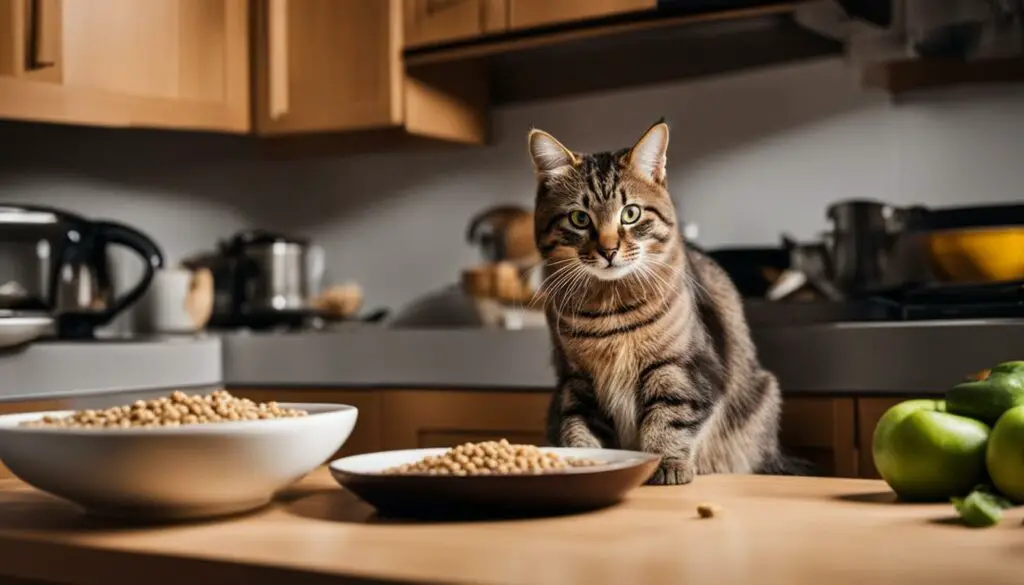
Cats Are Not Dogs: Your Cat Likes to Be Pet While Eating
Unlike dogs, many cats actually enjoy being petted while they eat. This behavior is rooted in the fact that cats have different social dynamics than dogs. While dogs may guard their food jealously, cats see petting while eating as a sign of love and trust from their owners. Understanding this behavior can help cat owners and shelter volunteers care for their feline friends.
When cats are petted while they eat, it creates a sense of security and comfort for them. It allows them to fully relax and enjoy their meal knowing that they are loved and protected. This behavior is especially important for cats who may have experienced trauma or have anxiety around mealtime. Petting while eating can help them feel safe and build trust with their caregivers.
“Cats see petting while eating as a sign of love and trust from their owners.”
A Sign of Affection
The act of petting a cat while they eat is a way for owners to show affection and strengthen their bond. Cats are known for their independent nature, but they still crave love and attention from their human companions. Petting them during mealtime not only satisfies their need for physical contact but also reinforces the emotional connection between cat and owner.
It’s important to note that not all cats enjoy being petted while they eat. Some cats may prefer to eat in solitude and may become agitated or anxious if approached while they are eating. As with any behavior, it’s important to observe your cat’s cues and respect their boundaries. If your cat doesn’t enjoy being petted while eating, try offering them a quiet and undisturbed space to enjoy their meal.
| Pros of Petting While Eating | Cons of Petting While Eating |
|---|---|
|
|
In conclusion, petting a cat while they eat is a behavior rooted in the unique social dynamics of cats. It can be a way to show love and trust while providing comfort and security during mealtime. However, it’s important to respect your cat’s preferences and boundaries, as not all cats enjoy being petted while eating. By understanding and observing your feline friend’s behavior, you can create a nurturing and supportive environment that meets their individual needs.
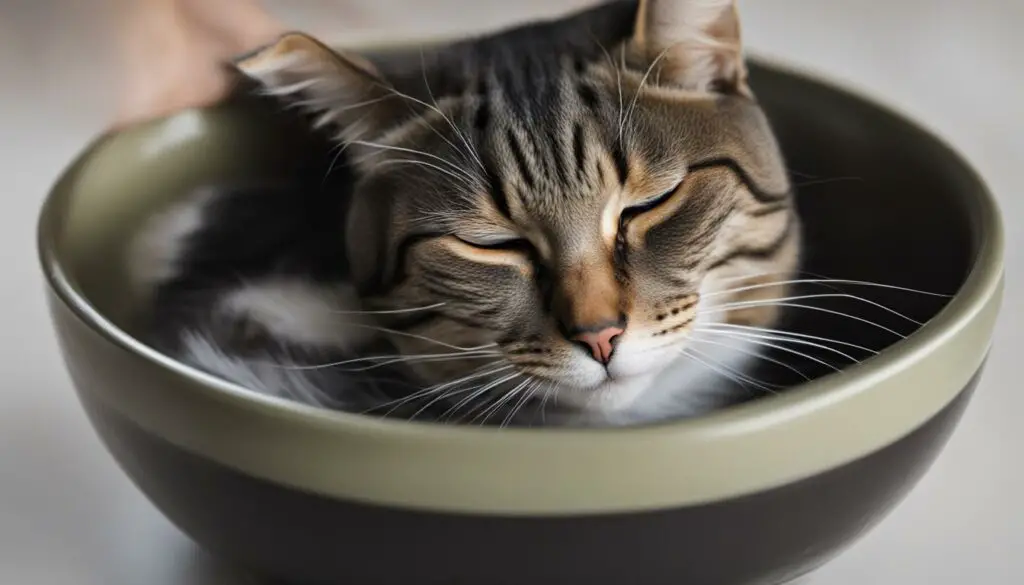
Befriending a Skittish Cat: Petting While Eating Can Help
If you have a skittish cat who is hesitant to trust you, mealtime can be a valuable opportunity to build a bond and establish a sense of safety. One effective technique is to pet your cat while they eat. This gentle interaction can help desensitize them to touch and gradually build trust.
Dilara Perry, a cat behavior consultant, advises starting with short periods of petting while your cat eats. Begin by offering a gentle stroke on their back or chin, and observe their reaction. If they seem comfortable, gradually increase the petting time during subsequent meals. The goal is to help the cat associate touch with positive experiences, reinforcing their sense of security.
By consistently petting your cat during mealtime, you can help them overcome their skittishness and develop a deeper bond with you. It’s important to remember that each cat is unique, so be patient and attentive to their individual needs and comfort levels.
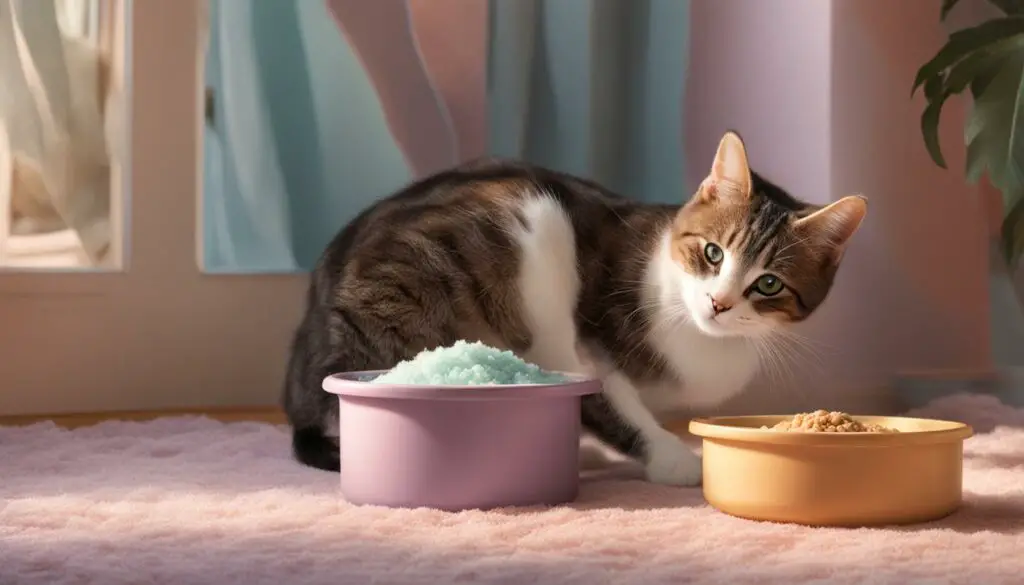
Benefits of Petting While Eating
- Builds trust: Petting your cat while they eat helps them associate your touch with positive experiences, fostering trust and a sense of security.
- Reduces anxiety: The presence of a familiar and caring human can help calm a skittish cat during mealtime, reducing anxiety and stress.
- Provides positive reinforcement: Petting while eating rewards your cat for engaging in a natural behavior, making mealtime a positive and enjoyable experience.
- Strengthens the bond: By sharing a mealtime routine that includes physical affection, you can strengthen the bond between you and your furry friend.
Cautionary Notes
While petting while eating can be beneficial, it’s essential to approach the process with sensitivity and respect for your cat’s boundaries. Here are a few things to keep in mind:
- Observe your cat’s body language: Pay attention to signs of discomfort or stress, such as flattened ears, a twitching tail, or attempts to move away. If your cat shows signs of distress, stop petting immediately.
- Start slowly: Introduce petting gradually and in short intervals, allowing your cat to adjust and build trust at their own pace.
- Respect personal space: Some cats may prefer minimal physical contact while eating. If your cat seems uncomfortable with petting, it’s important to respect their boundaries and find alternative ways to strengthen your bond.
Conclusion
Petting your skittish cat while they eat can be a powerful tool in building trust and deepening your relationship. By providing gentle affection and positive reinforcement during mealtime, you can help your cat overcome their anxiety and fear, creating a stronger bond of love and trust.
When Cats Stop Eating: Reasons and What to Do
It can be worrisome when your cat suddenly stops eating, especially if it persists for more than 24 hours. Loss of appetite in cats can be caused by a variety of reasons, both medical and psychological. Here are some common reasons why cats may stop eating and what you can do to help them:
Table: Common Reasons for Cats Not Eating
| Medical Reasons | Psychological Reasons |
|---|---|
| Gastrointestinal issues | Anxiety or stress |
| Dental problems | Change in environment |
| Illness or infection | Grief or loss |
“If your cat won’t eat for more than 24 hours, it’s important to take them to a vet for a thorough examination,” says Dr. Emily Thompson, a veterinarian specializing in feline medicine. “Loss of appetite can be a sign of an underlying medical condition that requires treatment. Additionally, stress or anxiety can also affect a cat’s appetite, so addressing any psychological factors is important as well.
During this time, it’s important to monitor your cat’s behavior, hydration, and litter box habits. If your cat continues to refuse food or shows signs of distress, seeking veterinary advice is crucial. The vet may recommend diagnostic tests, such as blood work or imaging, to identify the underlying cause.
In some cases, your vet may suggest appetite stimulants or alternative feeding methods to entice your cat to eat. It’s important to follow their guidance to ensure your cat receives the necessary nutrition and begins eating again.
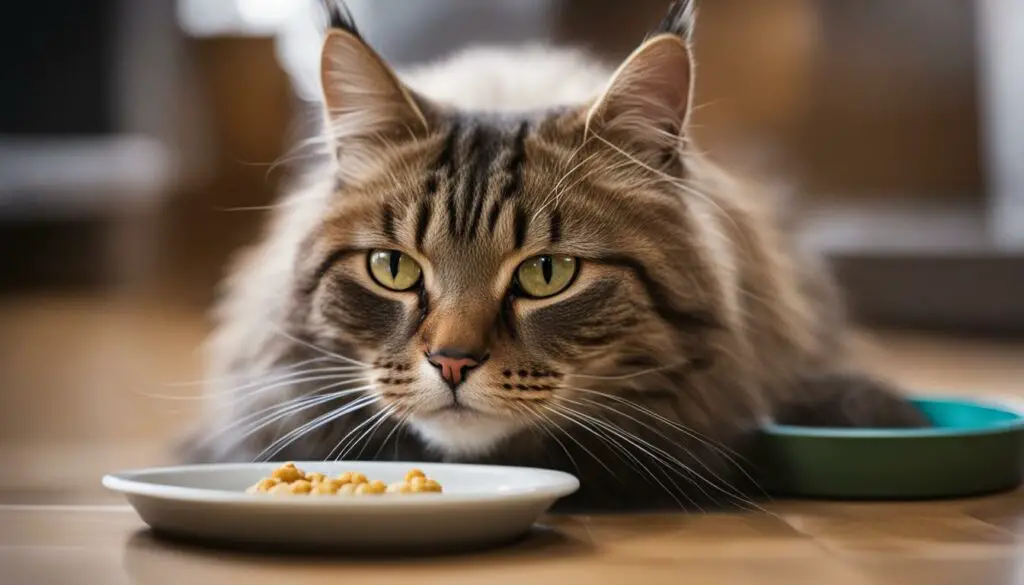
- Monitor your cat’s behavior and hydration levels.
- Consult a veterinarian if your cat refuses to eat for more than 24 hours.
- Follow the vet’s advice regarding diagnostic tests and treatment options.
- Consider alternative feeding methods or appetite stimulants recommended by the vet.
Feline Hepatic Lipidosis: The Importance of Getting a Cat to Eat
If a cat goes without eating for too long, it can lead to a condition called feline hepatic lipidosis, or fatty liver disease. This disease can be life-threatening and requires immediate veterinary intervention. It’s important to get a cat who won’t eat to the vet to prevent this condition and ensure they receive proper nutrition.
Feline hepatic lipidosis occurs when a cat’s body begins to break down stored fat for energy due to lack of food. This fat is then deposited in the liver, leading to liver failure. Cats who are overweight or obese are more susceptible to developing this condition.
There are several reasons why a cat may stop eating, including stress, illness, dental problems, or changes in their environment. If you notice that your cat is not eating or has a decreased appetite, it’s crucial to seek veterinary attention as soon as possible.
Without proper treatment, feline hepatic lipidosis can be fatal. Treatment often involves hospitalization, intravenous fluids, and a feeding tube to provide the cat with the necessary nutrition. The sooner the condition is diagnosed and treated, the better the chances of a full recovery.
| Signs of Feline Hepatic Lipidosis | Treatment Options |
|---|---|
| Loss of appetite | Hospitalization |
| Weight loss | Intravenous fluids |
| Lethargy | Feeding tube |
| Vomiting | Nutritional support |
| Jaundice | Pain management |
Preventing feline hepatic lipidosis starts with ensuring your cat maintains a healthy appetite. If your cat is not eating, try enticing them with different flavors and textures of food, warming their food to enhance the aroma, or hand-feeding small amounts of food. It’s important to work closely with your veterinarian to develop a feeding plan that will provide the necessary nutrients and encourage your cat to eat.

Remember, a cat that won’t eat is a cause for concern, and prompt veterinary attention is essential. By understanding the importance of getting a cat to eat, you can help prevent feline hepatic lipidosis and ensure the overall health and well-being of your feline companion.
Building Trust Through Affection Eating
Building trust with a cat can be a gradual process, especially if the cat is experiencing stress or a change in environment. Affection eating, where you pet your cat while they eat, can play a crucial role in building that trust. By offering food and affection together, you create a positive association for the cat between mealtime and your presence.
Consistent interaction and attention during mealtime can help a cat feel safe and comfortable, especially in unfamiliar surroundings. It shows them that you are a source of comfort and security. This can be particularly beneficial for rescue cats or cats that have experienced trauma in the past.
“Affection eating can be a way to build trust with a cat who is experiencing stress or a change in environment. Consistent interaction and attention during mealtime can help a cat feel safe and comfortable, especially in unfamiliar surroundings.”
It’s important to approach affection eating with patience and respect for the cat’s boundaries. Some cats may not feel immediately comfortable with being petted while they eat. It’s crucial to start slowly, observing your cat’s body language and only proceeding if they show signs of relaxation and enjoyment. Over time, they will grow more accustomed to the experience and trust will be built.
In conclusion, affection eating is a powerful tool for building trust with your cat. By offering food and affection together during mealtime, you can create a positive association and help ease their stress or anxieties. Remember to be patient, observe your cat’s comfort level, and gradually increase the level of interaction. With time, your cat will feel safe, loved, and secure.
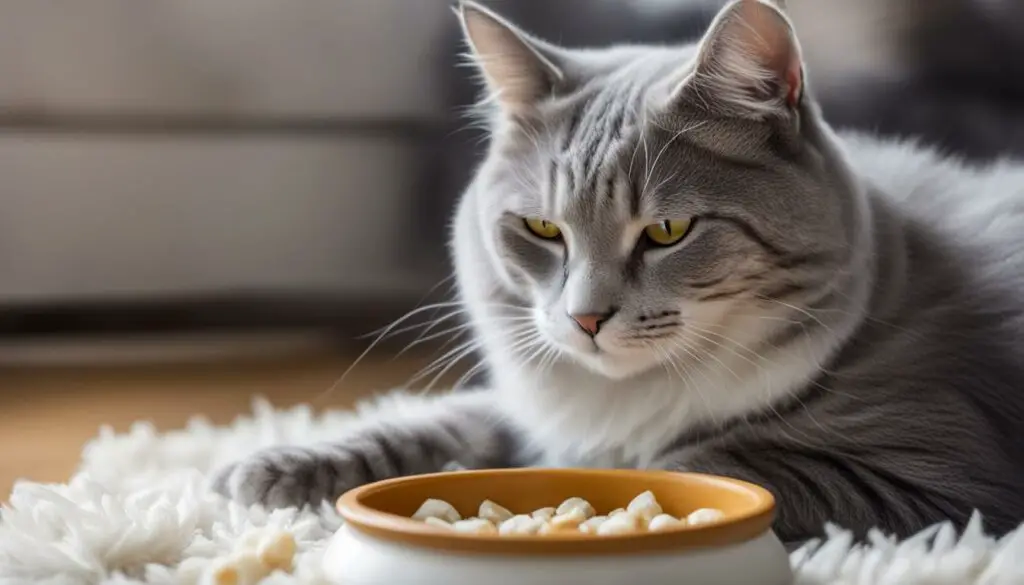
Facts about Affection Eating:
- Cats see petting while eating as a sign of love and trust.
- Affection eating can be particularly beneficial for rescue cats or those with past traumas.
- Approach affection eating with patience and respect for your cat’s boundaries.
- Start slowly and gradually increase the level of interaction.
- Building trust with your cat takes time and consistency.
Table: Benefits of Affection Eating
| Benefits | Description |
|---|---|
| Creates a positive association | Associates your presence with comfort and security during mealtime |
| Helps ease stress and anxiety | Provides a sense of safety and familiarity in unfamiliar surroundings |
| Strengthens the bond | Builds trust and deepens the connection between you and your cat |
Tips for Encouraging Eating: Variety and Affection
If your cat only eats when you pet him, there are a few tips that can help encourage him to eat more regularly. Firstly, try offering a variety of different foods. Cats can be picky eaters, so offering different flavors and textures can pique their interest and stimulate their appetite. You can also try different types of cat food, such as wet food or dry kibble, to see what your cat prefers.
Additionally, providing affection and attention while your cat eats can create a positive association with mealtime. Sit with your cat while he eats and gently stroke his fur. This can help him feel more relaxed and comfortable, making him more likely to eat. Remember, cats see petting while eating as a sign of love and trust, so offering affection during mealtime can be beneficial.
| Tip | More likely to eat? |
|---|---|
| Offer a variety of different foods | Yes |
| Provide affection and attention while eating | Yes |
| Stick to a regular feeding schedule | Yes |
| Ensure a calm and quiet eating environment | Yes |
Another important tip is to stick to a regular feeding schedule. Cats thrive on routine and having set mealtimes can help regulate their appetite and digestion. Try to feed your cat at the same times each day, and avoid leaving food out all day long. This can help create a routine and encourage your cat to eat when food is offered.
Lastly, it’s important to provide a calm and quiet eating environment for your cat. Eliminate any distractions, such as loud noises or other pets, that could make your cat feel anxious or stressed while eating. Creating a peaceful space can help your cat relax and focus on his meal.
The Importance of Regular Feeding Schedules
Establishing a regular feeding schedule is crucial for maintaining your cat’s overall health and well-being. Cats are creatures of habit and thrive on consistency, so providing them with regular meals at specific times can help regulate their appetite and digestion.
When cats are fed consistently, they develop a sense of routine and security, which can reduce stress and anxiety. This is particularly important for cats who only eat when they are petted, as a reliable feeding schedule can help them feel more comfortable and confident during mealtime.
Furthermore, regular feeding schedules can help prevent common issues such as obesity and digestive problems. By controlling the timing and portion sizes of your cat’s meals, you can ensure that they are receiving the appropriate amount of food for their size and activity level.
| Benefits of Regular Feeding Schedules | |
|---|---|
| Promotes healthy eating habits | 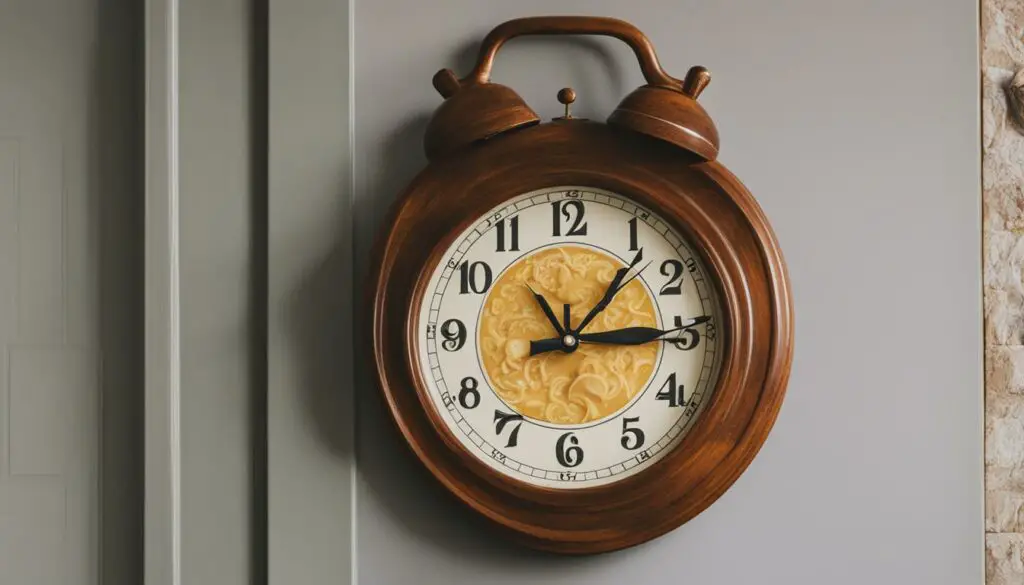 |
| Reduces the risk of obesity | |
| Prevents digestive issues | |
| Establishes a sense of routine and security |
Additionally, a consistent feeding schedule can help you monitor your cat’s appetite and detect any changes in their eating habits. If your cat suddenly refuses to eat or shows a decreased appetite, it could be a sign of an underlying health issue. By closely observing their feeding behavior, you can quickly identify any potential problems and seek veterinary care when necessary.
Overall, implementing a regular feeding schedule is essential for ensuring your cat’s proper nutrition, maintaining a healthy weight, and establishing a positive mealtime routine. By providing your furry friend with the structure and consistency they need, you can support their overall well-being and strengthen the bond between you and your cat.
Understanding Cat Behavior and Body Language
Understanding your cat’s behavior and body language is crucial for building a strong bond and providing the best care. Cats communicate through their body postures, facial expressions, and vocalizations, and by observing these cues, you can gain insight into their needs and emotions.
One key aspect of cat behavior is their response to food and petting. Many cats exhibit affection eating, where they prefer to be petted while they eat. This behavior stems from their unique social dynamics, as cats interpret petting during mealtime as a sign of love and trust from their owners. By understanding this behavior, you can create a positive association with food and deepen your bond with your feline companion.
To better interpret your cat’s behavior, it’s essential to pay attention to their body language. When a cat is comfortable and content, they may display relaxed body postures, such as a relaxed tail, soft eyes, and ears facing forward. On the other hand, if a cat feels threatened or anxious, they may exhibit defensive behaviors like hissing, growling, or flattening their ears against their head. By recognizing these signals, you can respond appropriately and create a safe environment for your cat.
Common Cat Body Language Signals:
- Ears forward: Indicates attentiveness and curiosity.
- Tail held high: Shows confidence and a friendly disposition.
- Tail tucked between legs: Signifies fear or submission.
- Purring: Indicates contentment and relaxation.
- Hissing or growling: Suggests fear or aggression.
Remember, each cat is unique, and their behavior may vary based on their personality and past experiences. Building a strong bond with your cat requires patience, understanding, and open communication. By observing their behavior and responding accordingly, you can create a loving and enriching environment for your feline friend.
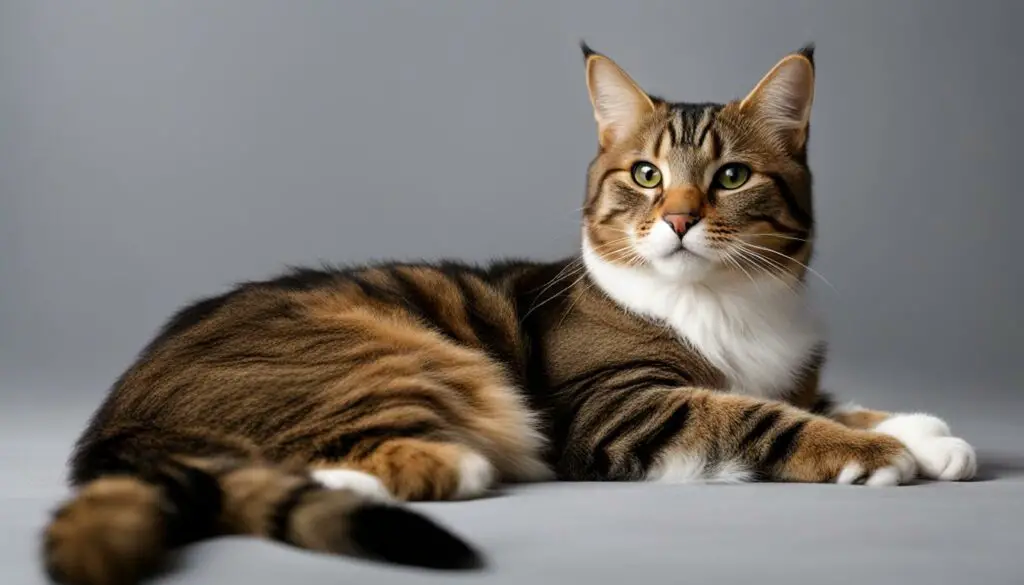
Table: Common Cat Body Language Signals
| Behavior | Meaning |
|---|---|
| Ears forward | Attentiveness and curiosity |
| Tail held high | Confidence and friendliness |
| Tail tucked between legs | Fear or submission |
| Purring | Contentment and relaxation |
| Hissing or growling | Fear or aggression |
Cat Behavior: Why Cats Knock Things Over
If you’ve ever wondered why your cat has a tendency to knock things over, you’re not alone. This behavior is actually quite common among felines and can be attributed to their natural instincts and desire for stimulation. Cats have an innate curiosity and a need to explore their surroundings, and knocking things over provides them with a sense of entertainment and satisfaction.
When a cat knocks something over, it can also be a way for them to get attention from their owners. They are aware that this behavior often elicits a response or interaction, which can be rewarding for them. It’s their way of engaging with their human companions and seeking attention or playtime.
Additionally, knocking things over can be a way for cats to simulate hunting behavior. In the wild, cats would use their paws and claws to catch and manipulate their prey. By knocking objects off surfaces, they are tapping into their natural instincts and satisfying their predatory drive.
| Reasons Why Cats Knock Things Over | Explanation |
|---|---|
| Curiosity and exploration | Cats are naturally curious creatures and enjoy investigating their environment. Knocking things over allows them to interact with objects and explore their surroundings. |
| Seeking attention | Cats are smart and know that knocking things over often leads to a response from their owners. It can be a way for them to initiate play or receive attention. |
| Hunting simulation | Knocking things over can mimic the hunting behavior of cats in the wild. It provides them with mental and physical stimulation as they engage their predatory instincts. |

Preventing and Redirecting the Behavior
If you find your cat’s penchant for knocking things over to be problematic, there are steps you can take to prevent or redirect the behavior. Providing your cat with plenty of stimulation, such as interactive toys and scratching posts, can help satisfy their need for physical activity and mental engagement. This can help divert their attention from knocking things over.
Placing valuable or fragile items out of your cat’s reach can also be helpful. By removing the temptation, you reduce the likelihood of items being knocked over and damaged. Additionally, ensuring that your cat has designated spaces where they can climb, explore, and play can help redirect their energy and focus.
Remember, knocking things over is a natural behavior for cats, so it’s important to approach the issue with patience and understanding. By providing alternatives and outlets for their energy, you can help minimize the likelihood of destructive behavior while still allowing them to express their natural instincts.
The Fascination with Licking Plastic
Some cats have a strange fascination with licking plastic objects. This behavior can be caused by several reasons, including an eating disorder called Pica or a vitamin/mineral deficiency. It’s important to remove access to plastic objects and provide appropriate toys and stimulation to redirect this behavior.
Licking plastic can be harmful to cats as it can lead to ingestion of plastic pieces, which can cause blockages in their digestive system. Pica, the compulsive eating of non-food items, is often linked to boredom or stress. If your cat is showing a persistent interest in licking plastic objects, it’s important to consult with your veterinarian to rule out any underlying medical conditions or deficiencies.
“Cats may engage in unusual behaviors such as licking plastic due to their natural curiosity and exploration instincts. It’s essential for cat owners to ensure a safe environment and provide appropriate stimulation to prevent them from engaging in potentially harmful behaviors.”
Redirecting the Behavior
To discourage your cat from licking plastic, it’s crucial to provide alternative options for stimulation. Engage your cat in interactive play sessions using toys that mimic hunting and prey behaviors. Puzzle toys and treat-dispensing toys can also help redirect their attention and provide mental stimulation. Additionally, ensure your cat’s environment is enriched with scratchers, climbing trees, and hiding spots to keep them mentally and physically engaged.
If your cat’s licking behavior persists despite environmental enrichment, your veterinarian may recommend dietary changes or supplements to address any nutritional deficiencies. They can also provide guidance on behavior modification techniques to redirect their attention to more appropriate behaviors. Remember, patience and consistency are key when trying to change your cat’s behavior.
| Potential Causes of Licking Plastic | How to Redirect the Behavior |
|---|---|
| Pica (compulsive eating of non-food items) | Provide alternative toys and stimulation, consult with a veterinarian for behavior modification techniques |
| Vitamin or mineral deficiency | Consult with a veterinarian for dietary changes or supplements |
| Boredom or lack of environmental enrichment | Engage in interactive play sessions, provide puzzle toys and treat-dispensing toys, enrich the environment with scratchers and climbing trees |
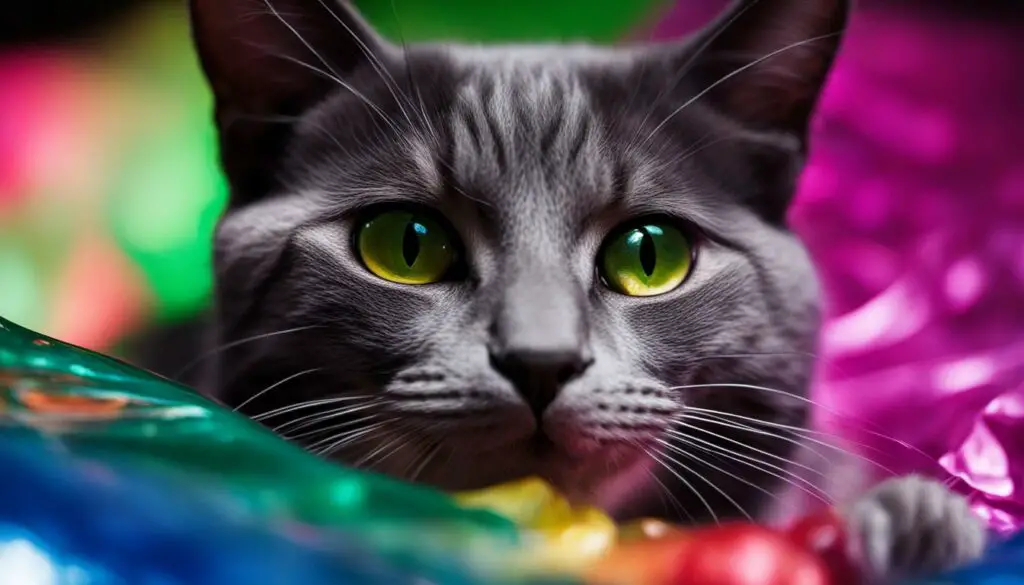
To keep your cat safe and healthy, it’s important to address their fascination with licking plastic objects. By understanding the potential causes and redirecting their behavior through environmental enrichment and appropriate stimulation, you can help ensure your cat’s well-being. Remember to consult with your veterinarian for any concerns or persistent behaviors.
Understanding Why Cats Bring Home “Gifts” of Dead Animals
If you’ve ever been the recipient of a “gift” from your cat in the form of a dead animal, you may be wondering why cats engage in this behavior. While it may seem strange or even unsettling to us, bringing home dead animals is actually a natural instinct for cats. In the wild, cats are hunters, and this behavior stems from their natural drive to provide for their owners and show affection.
When a cat brings you a dead animal, it is essentially sharing its hunting success with you. It sees you as part of its extended family, and offering you this gift is a way for your cat to demonstrate its love and appreciation. While it may not be a gift that we humans necessarily appreciate, it’s important to understand that this behavior is deeply ingrained in a cat’s instinctual behaviors.
So, how should you react when your cat brings home a dead animal? It’s important to resist the urge to scold or punish your cat. Instead, you can express your appreciation for the gesture by calmly praising your cat and offering verbal or physical affection. You can also redirect their hunting instincts by providing them with interactive toys or play sessions to satisfy their natural drive to stalk and capture prey.
| Reasons Why Cats Bring Home Dead Animals | What You Can Do as a Cat Owner |
|---|---|
|
|
|
|
|
|
|
|
|
Remember, when your cat brings home a “gift” of a dead animal, it is simply following its natural instincts and showing its love and trust in you. While it may not be the most pleasant surprise, understanding the motivation behind this behavior can help you respond in a loving and supportive way.
Decoding the Intense Stares of Cats
Cats have a unique way of communicating with their intense stares. When a cat locks eyes with you, it can mean different things depending on the context. Their eye contact is a way for them to convey curiosity, love, hunger, or a desire to play. It’s important to pay attention to their body language alongside their intense gaze to gain a deeper understanding of their needs and emotions.
One common reason for a cat’s intense stare is curiosity. Cats are naturally curious creatures, and when they fix their gaze on something or someone, it’s because they’re intrigued and want to investigate further. They might be observing your movements, trying to figure out what you’re doing, or simply exploring their environment through their keen sense of sight.
Additionally, an intense stare from your cat can indicate love and affection. Cats may gaze at their owners with soft, relaxed eyes, showing that they feel safe, comfortable, and content in their presence. It’s their way of expressing love and building a bond with you. Return their gaze with a gentle smile or a blink to acknowledge their affection, further strengthening your connection.
Furthermore, a cat’s intense stare can also signify their desire for food. Hunger is a powerful motivator for cats, and when they stare at you with a focused gaze, it’s their way of communicating that they’re ready to be fed. They might even use their stare as a way to remind you of their daily feeding schedule or to get your attention and encourage you to provide a meal.
| Reasons Behind a Cat’s Intense Stare | Meaning |
|---|---|
| Curiosity | The cat is intrigued and wants to explore further. |
| Love and Affection | The cat feels safe, comfortable, and content in your presence. |
| Hunger | The cat is ready to be fed and wants to get your attention. |
It’s important to note that while an intense stare from a cat can be endearing and meaningful, it’s crucial to respect their personal space and boundaries. Some cats may feel threatened or uncomfortable with prolonged direct eye contact, especially if they are anxious or cautious by nature. Always observe their body language and respond accordingly, creating an environment where they feel safe and respected.
By decoding your cat’s intense stares and understanding their subtle cues, you can deepen your bond and provide the care and attention they need. Whether it’s curiosity, love, or hunger, their intense gaze offers a window into their thoughts and emotions. Embrace these moments of connection and cherish the unique ways in which cats communicate.
The Meaning Behind Biting and Licking Behavior
One interesting aspect of feline behavior is their tendency to exhibit biting or licking behaviors. These behaviors can serve different purposes and can be influenced by various factors. It’s important for cat owners to understand the meaning behind these behaviors and how to respond appropriately to ensure the well-being of their furry friends.
Biting behavior in cats can have several motivations. Sometimes, cats may bite as a form of play. This can be seen when they engage in gentle nibbling or playfully bite during interactive play sessions. Additionally, biting can also be a sign of affection. Cats may give gentle love bites as a way to express their love and attachment to their owners.
On the other hand, licking behavior can also have multiple meanings. Cats commonly lick themselves as a way to groom and clean their fur. However, excessive licking in specific areas can indicate discomfort or potential health issues. If you notice that your cat is excessively licking a particular spot, it’s important to examine the area for any signs of injury or irritation.
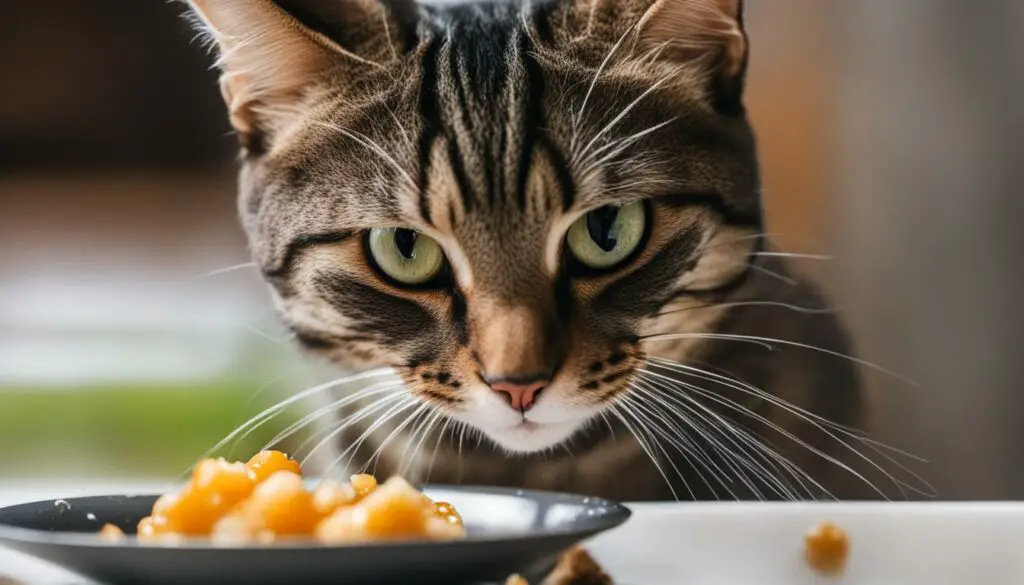
Table: Common Reasons for Biting and Licking Behavior in Cats
| Behavior | Meaning |
|---|---|
| Playful Biting | A form of play and interaction |
| Affectionate Biting | An expression of love and attachment |
| Grooming Licks | Self-grooming behavior for cleanliness |
| Excessive Licking | Possible discomfort or health issues |
It’s essential to pay attention to your cat’s body language and context when interpreting biting and licking behaviors. If your cat’s biting becomes aggressive or causes harm, it’s important to set boundaries and redirect their behavior towards appropriate toys or play activities. Similarly, if your cat’s licking behavior becomes excessive or leads to skin irritation, consult with a veterinarian to identify any underlying health conditions.
By understanding the meaning behind biting and licking behavior, cat owners can better engage with their furry friends and provide the care and attention they need. Building a strong bond with your cat involves observing their behavior, respecting their boundaries, and ensuring their physical and emotional well-being.
Conclusion
Understanding your cat’s behavior is key to strengthening the bond between you and ensuring their overall well-being. One intriguing behavior that some cats exhibit is affection eating, where they only eat when you pet them. This behavior serves as a way for cats to build a deeper connection with their owners and feel secure while enjoying their meals.
Additionally, we’ve explored various other fascinating feline behaviors, such as knocking things over, licking plastic objects, bringing home “gifts” of dead animals, intense stares, and biting or licking behavior. Each of these behaviors has its own unique purpose and communication method, allowing cats to express their natural instincts and needs.
By observing and responding to these behaviors appropriately, you can create a loving and enriching environment for your furry friend. Remember, establishing regular feeding schedules, offering a variety of foods, and providing affection and attention during mealtime can all contribute to a positive eating experience for your cat. Additionally, understanding their body language and context will help you respond to their needs and strengthen the bond you share.
So, the next time your cat only eats when you pet them, embrace it as a heartwarming way for them to connect with you. By nurturing these unique feline behaviors, you are nurturing the special relationship you have with your beloved cat.
FAQ
Why does my cat only eat when I pet him?
This behavior, known as affection eating or attention eating, is a way for cats to bond with their owners and feel safe while eating.
What is affection eating in cats?
Affection eating, also known as attention eating, is a behavior exhibited by many cats where they enjoy being petted while they eat. It helps them build a bond with their owners and feel secure during mealtime.
Why do cats like to be pet while eating?
Cats see petting while eating as a sign of love and trust from their owners. It is a behavior rooted in their social dynamics and differs from dogs, who may guard their food jealously.
How can petting a cat while it eats help build trust?
For skittish cats, mealtime can be an opportunity to build trust and a relationship. By incrementally increasing petting time while the cat eats, you can help them become more comfortable with touch and gradually build a bond.
Why is it important to take a cat to the vet if it won’t eat?
If a cat stops eating for more than 24 hours, it may be a sign of a more serious issue such as dental problems or psychological stress. Taking them to the vet is important to diagnose the problem and get them eating again.
What is feline hepatic lipidosis?
Feline hepatic lipidosis, also known as fatty liver disease, is a life-threatening condition that can occur in cats who are not eating. It requires immediate veterinary intervention, making it important to get a cat who won’t eat to the vet.
How can affection eating help cats in unfamiliar surroundings?
Affection eating can help cats feel safe and comfortable, especially in unfamiliar surroundings. By offering food and affection together, you can help them overcome anxiety and build a stronger bond.
What can I do to encourage my cat to eat?
Trying a variety of different foods can stimulate their appetite. Cats can be picky eaters, so offering different flavors and textures may entice them. Providing affection and attention while they eat can also create a positive association with mealtime.
Why is establishing a regular feeding schedule important for cats?
Cats thrive on consistency and routine. By feeding your cat at the same times every day, you can help regulate their appetite and digestion, ensuring they eat regularly and maintain a healthy eating habit.
How can I understand my cat’s behavior and body language?
Cats communicate through their body postures, facial expressions, and vocalizations. By observing and understanding their behavior, you can better respond to their needs and provide the appropriate care.
Why do cats knock things over?
Knocking things over can be a way for cats to simulate hunting behavior and engage their natural instincts. It may also be a way for them to get attention from their owners.
Why do cats have a fascination with licking plastic objects?
Licking plastic objects can be caused by an eating disorder called Pica or a vitamin/mineral deficiency. It’s important to remove access to plastic objects and provide appropriate toys and stimulation to redirect this behavior.
Why do cats bring home “gifts” of dead animals?
Cats have a natural instinct to hunt and provide for their owners. Bringing home dead animals is their way of showing affection and sharing their hunting success.
What do intense stares from cats mean?
Cats use eye contact to convey various messages such as curiosity, love, hunger, or a desire to play. Understanding their body language and context can help you respond appropriately to their needs and strengthen your bond.
Why do cats exhibit biting and licking behavior?
Biting and licking behavior in cats can be a form of play, a sign of affection, or a way to communicate. It’s important to pay attention to their body language and context to ensure their behavior is not aggressive or due to discomfort.
Why is understanding cat behavior important?
Understanding your cat’s behavior can help strengthen your bond and ensure their well-being. By observing and responding to their behaviors appropriately, you can provide a loving and enriching environment for your furry friend.

